If you have always wanted to go on a safari, Tanzania is a great option. By visiting both the massive grasslands of Serengeti and the lush vegetation in Ngorongoro, you are sure to spot a lot of wildlife.
In the week between climbing Mount Kilimanjaro and Mount Kenya a few years ago we took advantage of being in Africa and went on a few safaris. Even though its incredibly touristy, being able to see the vast amounts of wild animals up close was an incredible experience. In Tanzania we went to Serengeti and Ngorongoro Crater.
Serengeti National Park
Serengeti is a huge grassland park with a wide-open landscape that allows you to see wildlife in every direction. Elephants, giraffes, zebras, buffaloes, gazelles and impalas could be seen grazing in the distance. As we drove through the park we were surprised at how close we could get to some of these animals without them seemingly noticing our presence.
We were not in Serengeti during the famous wildebeest migration, but felt as if we were. We were near a large herd of wildebeests when, for no apparent reason, the whole herd frantically raced across the plain. It was very impressive, and allowed us to imagine how incredible it would be to see the migration.

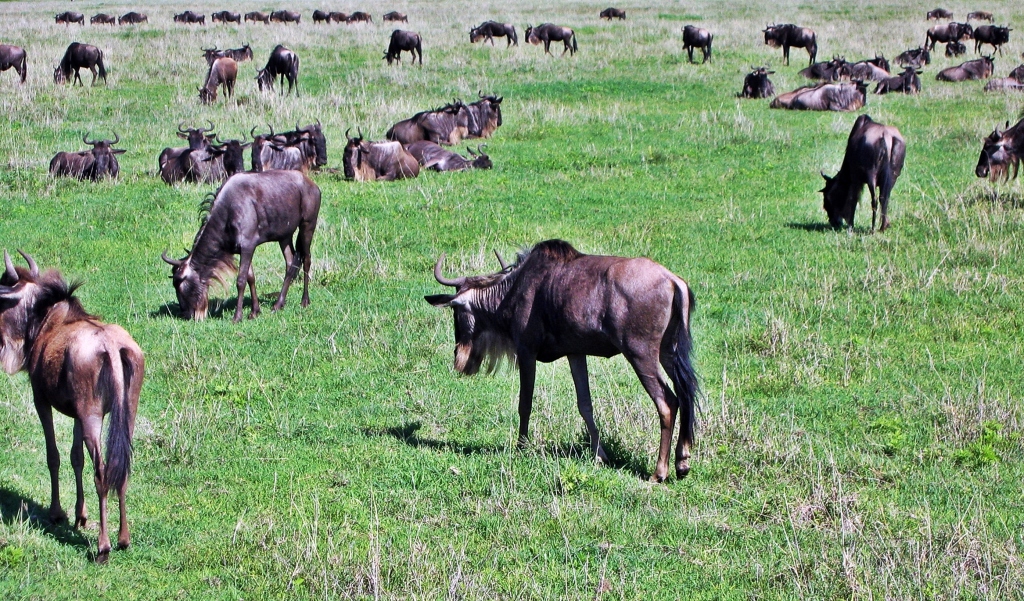
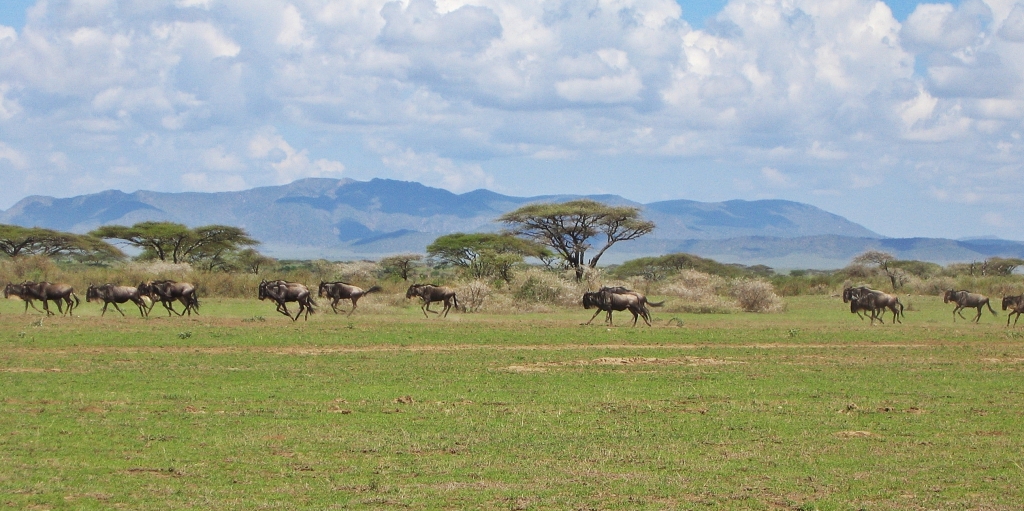
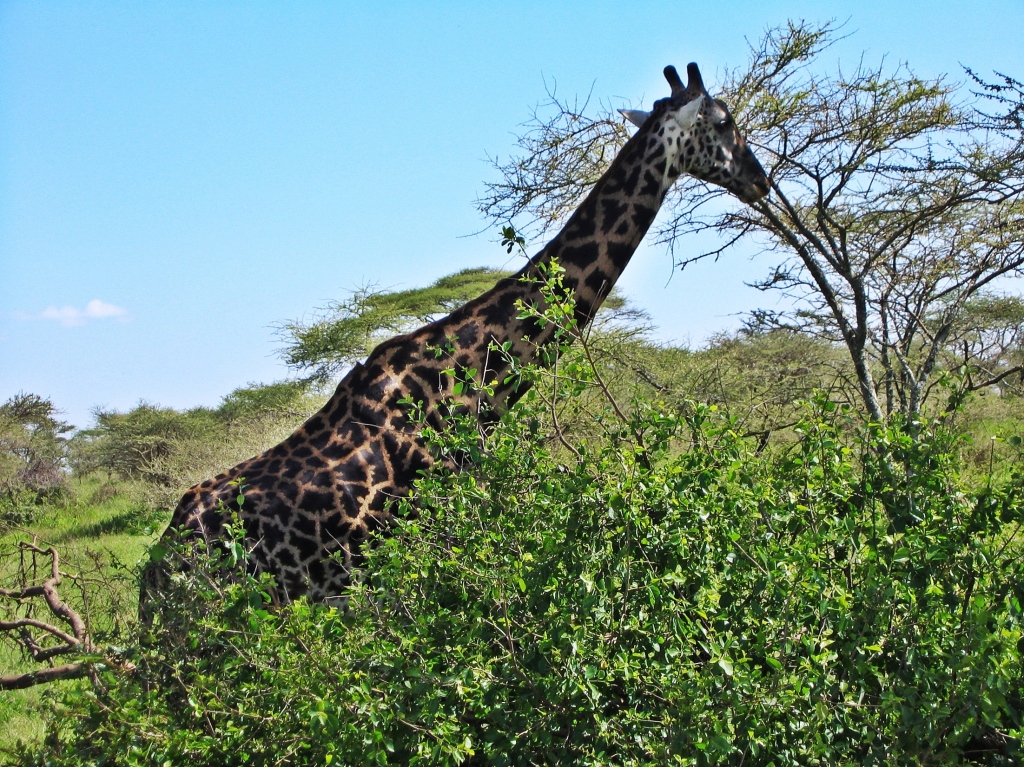
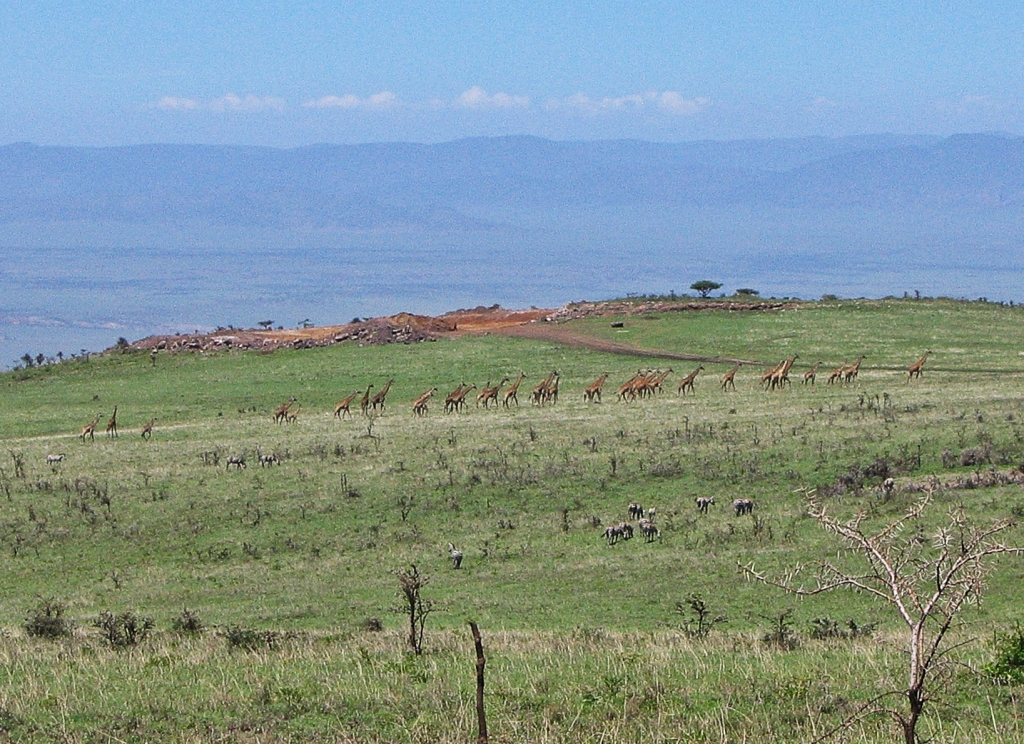
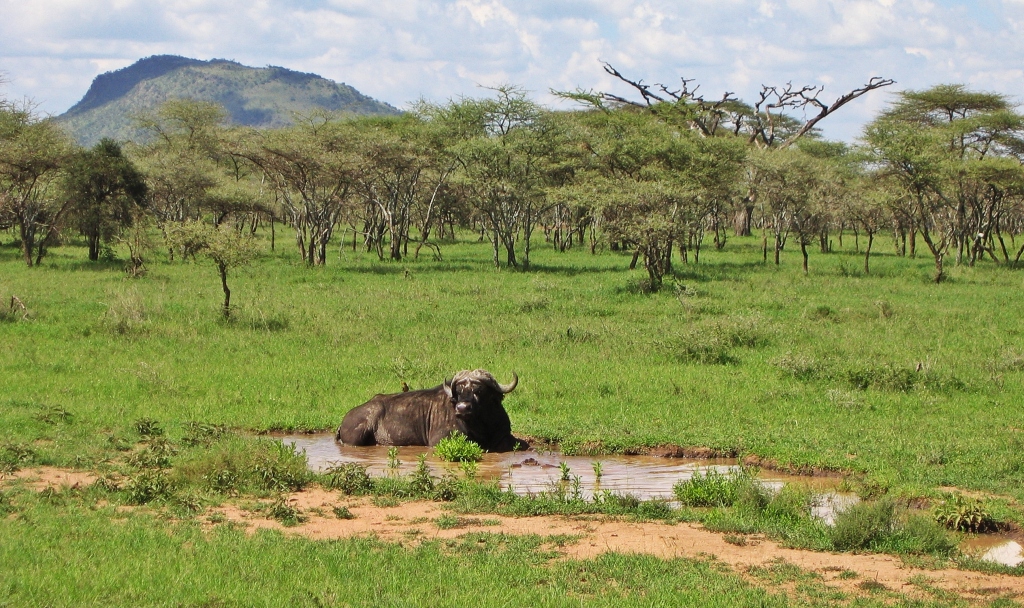
The park has many cats including lions, cheetahs and leopards. Lions were often on rock outcrops called kopjes. One large male sat on top of the kopjes as if in a scene from the ‘Lion King’ movie. Others were seen resting under the shade of a tree.
Leopards were more difficult to find. Serengeti can be a busy park but our safari driver was usually able to keep us away from the crowds. However things changed when the location of a hard to spot leopard was announced on the CB radio. Our jeep along with many others raced to descend on the cat’s location. This was probably our biggest disappointment and left us feeling ashamed for getting caught up in the excitement. The leopard was high up in a tree, and we could only see his waging tail.
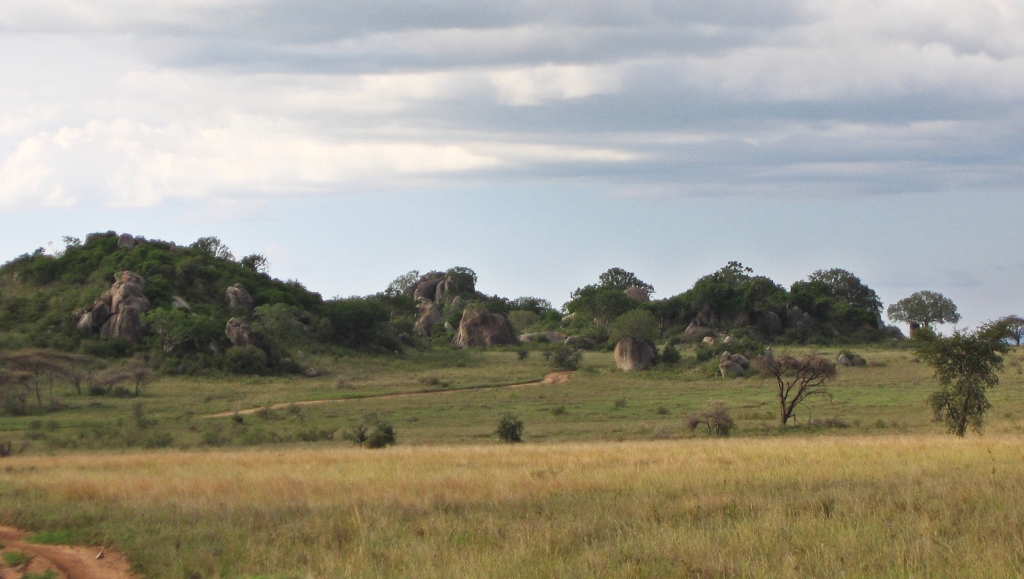
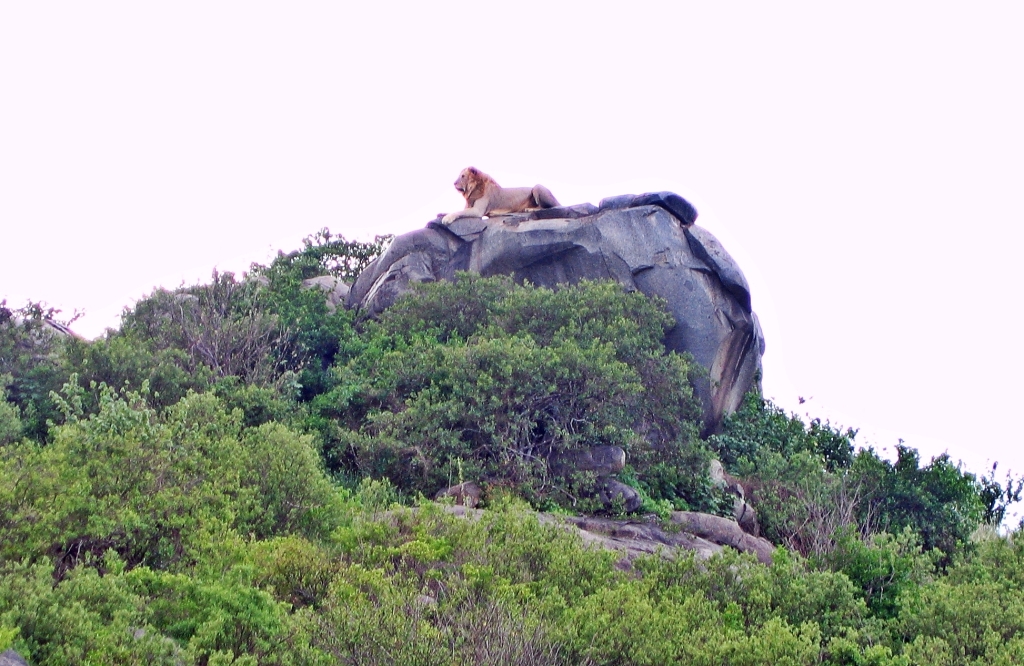
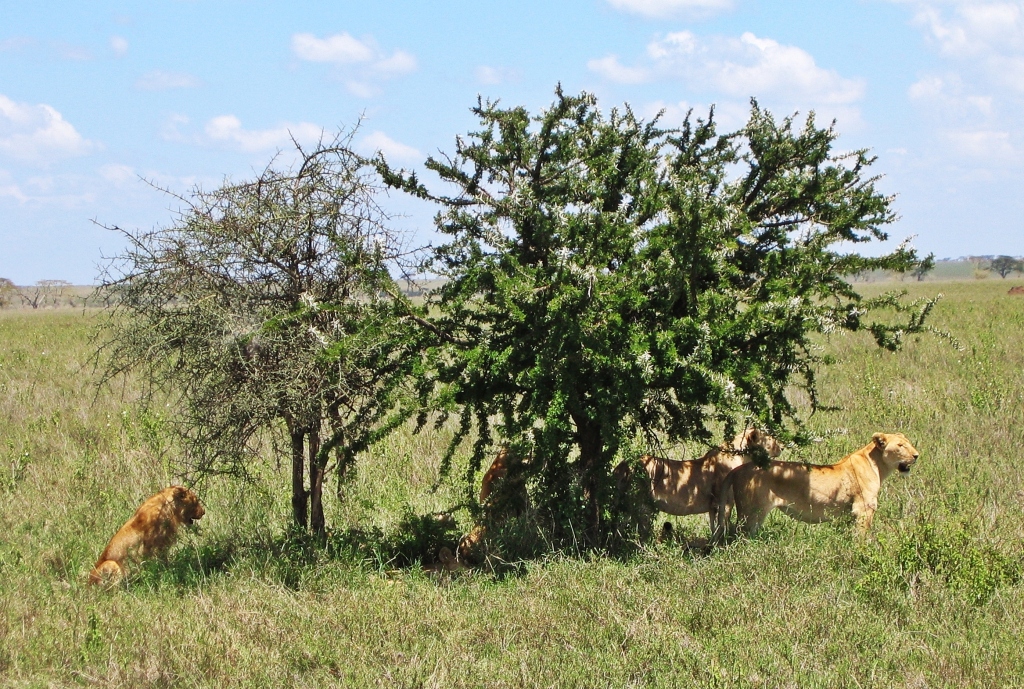
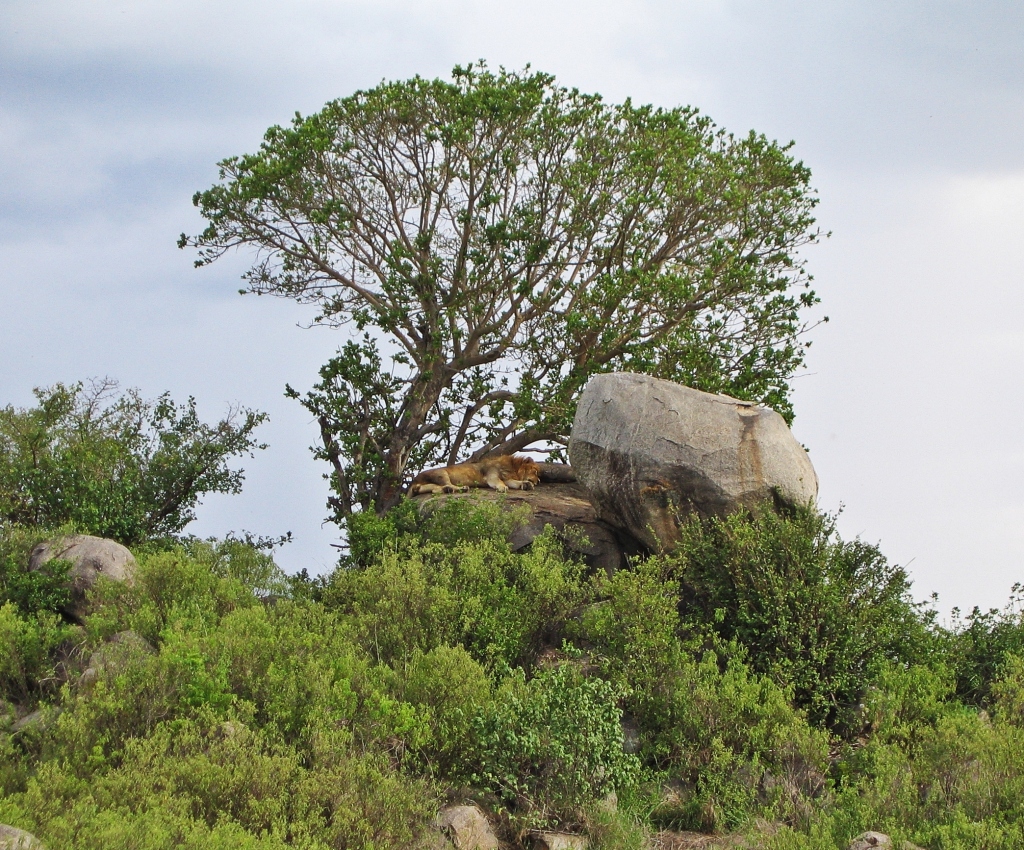
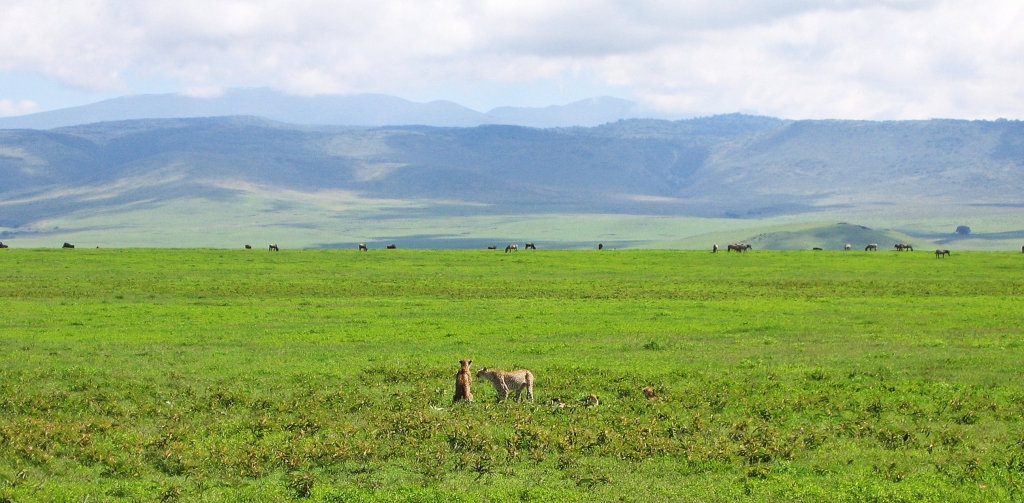
Even though the majority of the Serengeti is grassland, there are a large number of acacia and other trees. Acacias have the distinctive flat top frequently seen in pictures from Africa. We also saw a few baobab trees with their awkward large trunks holding up a large canopy. The park also has a few small lakes and ponds. These were places where various birds and hippos can be found.
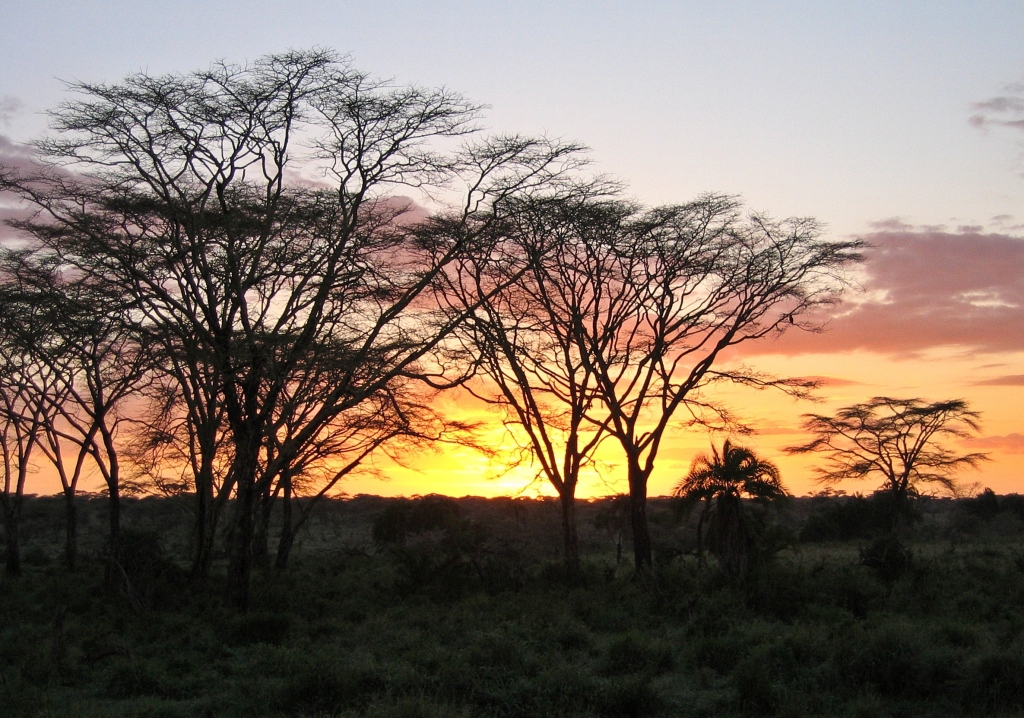
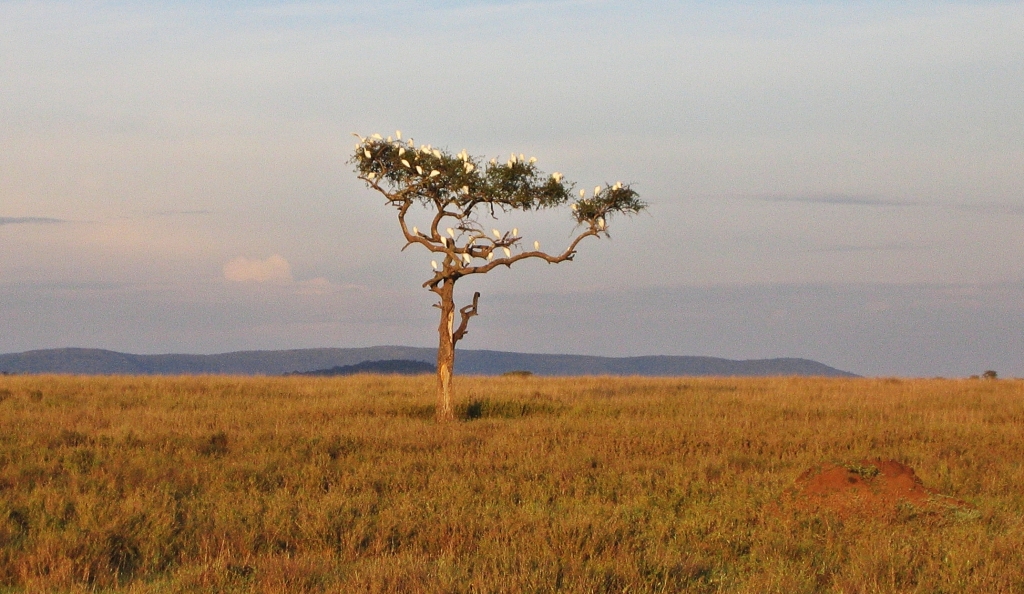

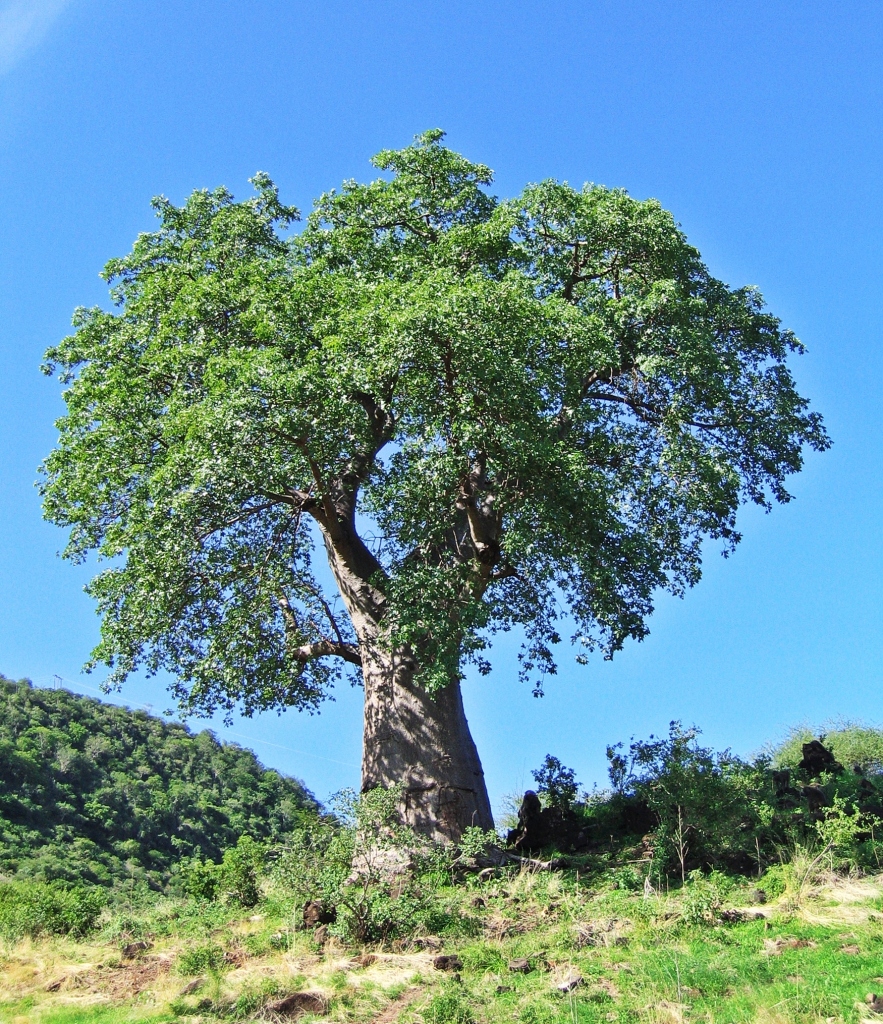
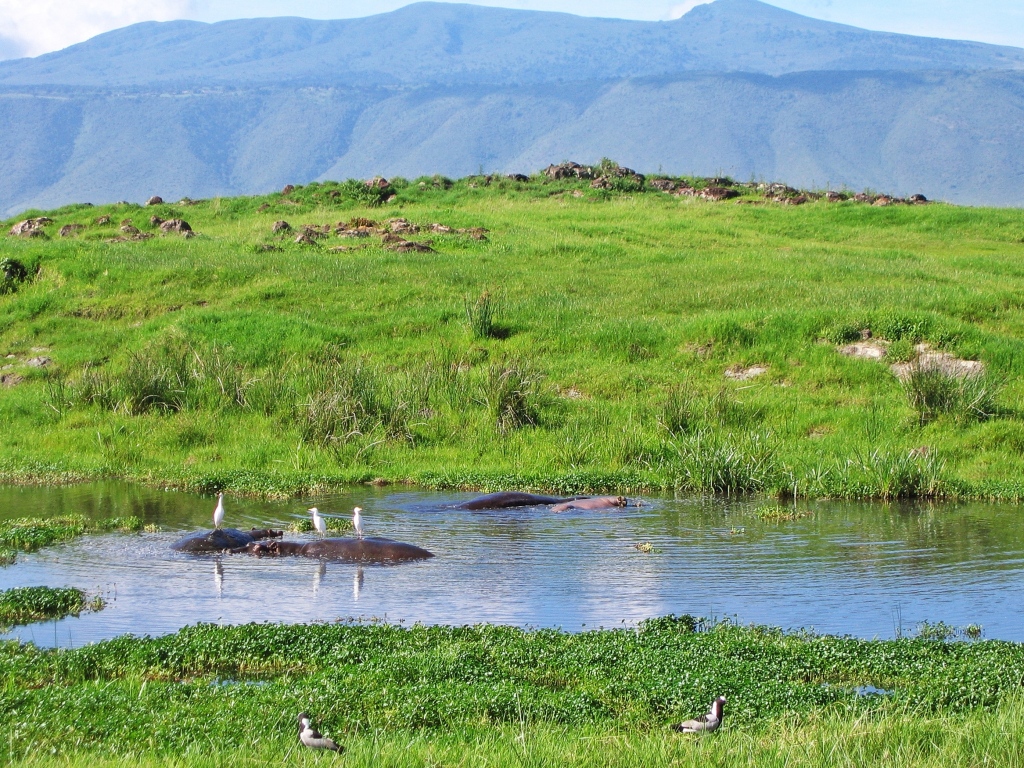
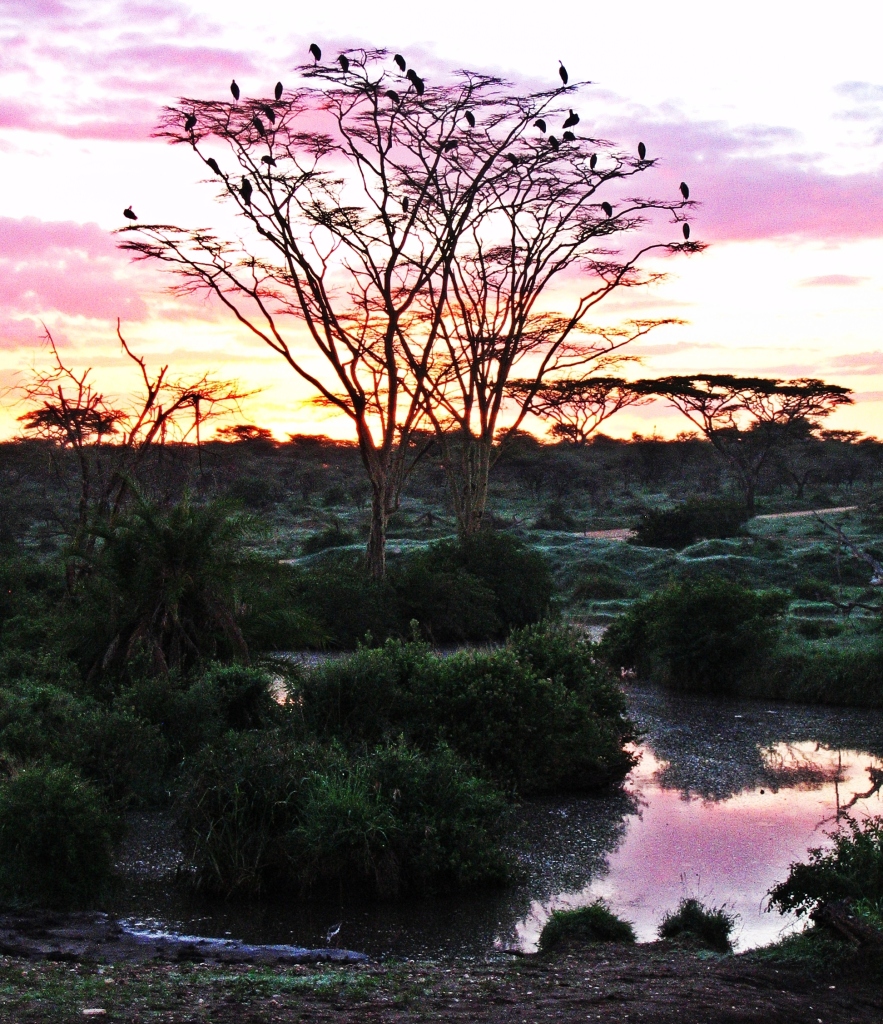
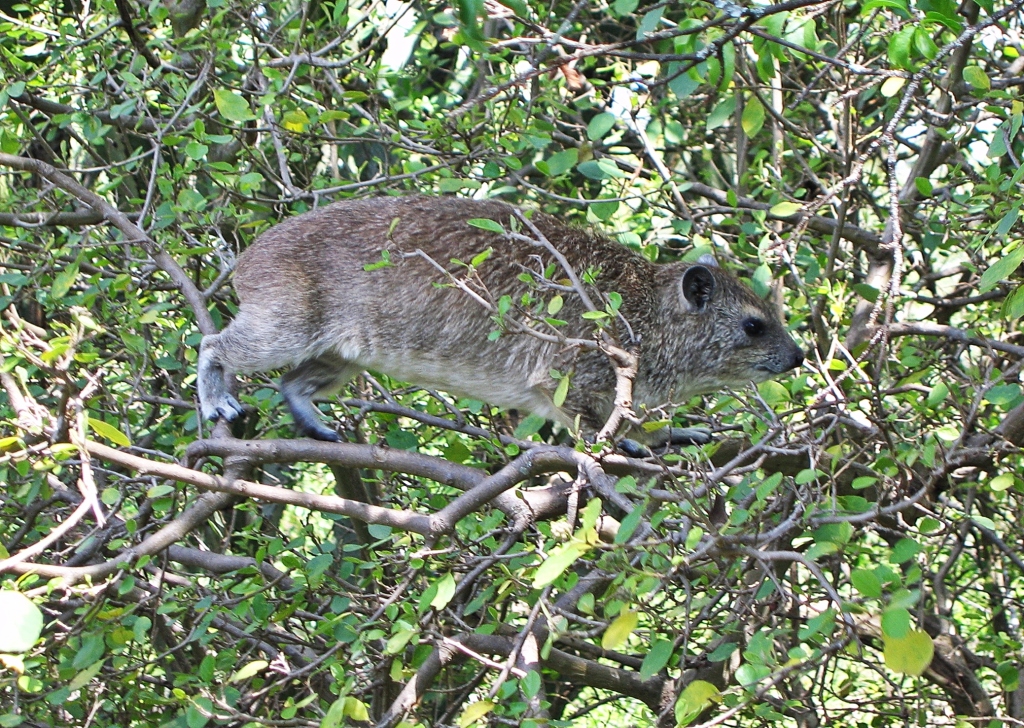
As part of our safari package, we camped for two nights inside the park. The campground had an armed guard patrolling the perimeter and a fence around the dining hall. Even still, we were not completely safe. During one dinner, a wild elephant came storming inside the campground and headed toward the dining tent. There was a mad scramble to get out of the way. Our guide said the elephant was likely searching for water. That night Richard heard lions roaring and swears they was right outside our tent. And then, after sleeping two nights in the same spot, we packed up the tent and spotted a crushed scorpion under the place where Maggie slept!
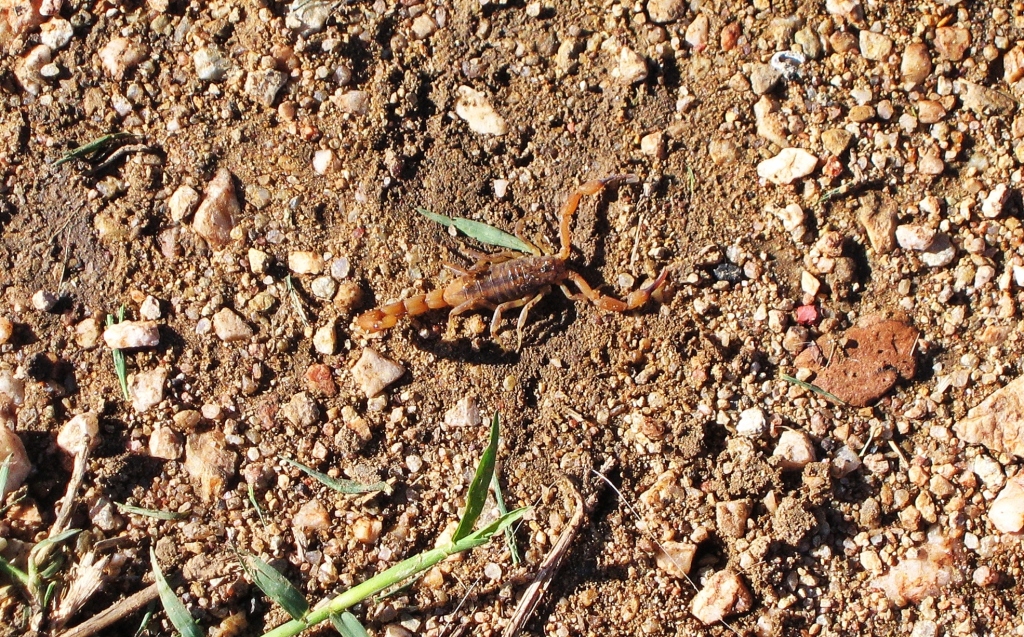
Ngorongoro Conservation Area
The Crater Highlands is an interesting part of Tanzania. It gets its name from the collapsed volcanoes that are found here. One of these craters has a unique ecosystem and is the perfect setting for a safari. Ngorongoro Crater is 20 km wide and is filled with grasslands, forests, freshwater lakes, swamps and salt pans. We stopped on the crater’s rim where we could see the tall, steep wall. Animals are able to walk in and out, however most don’t leave because of the rich source of food and water inside. Compared to the Serengeti, Ngorogoro is very green and lush. It felt like the garden of Eden.
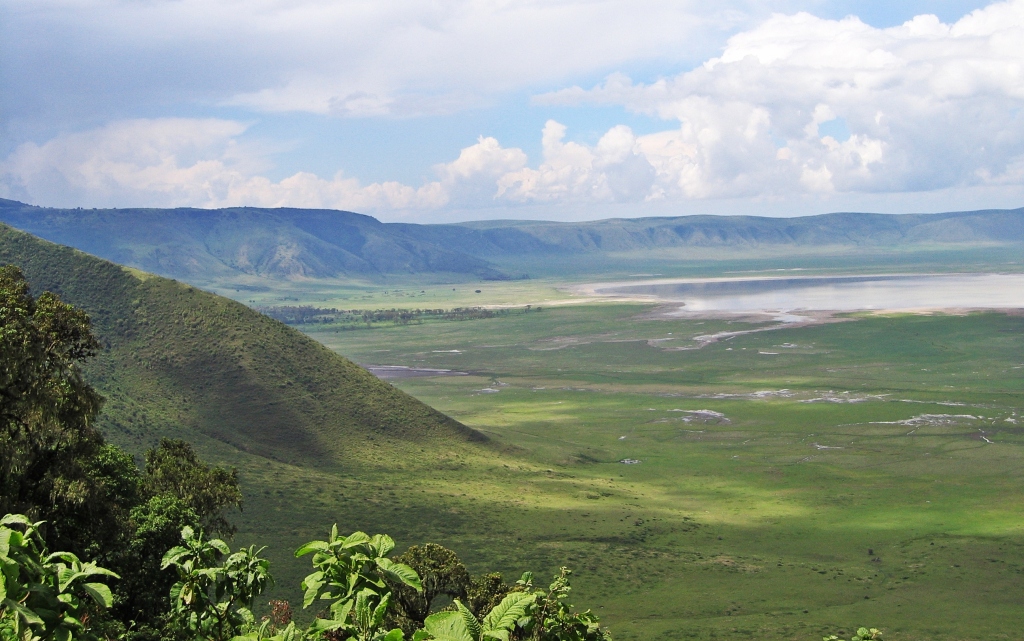
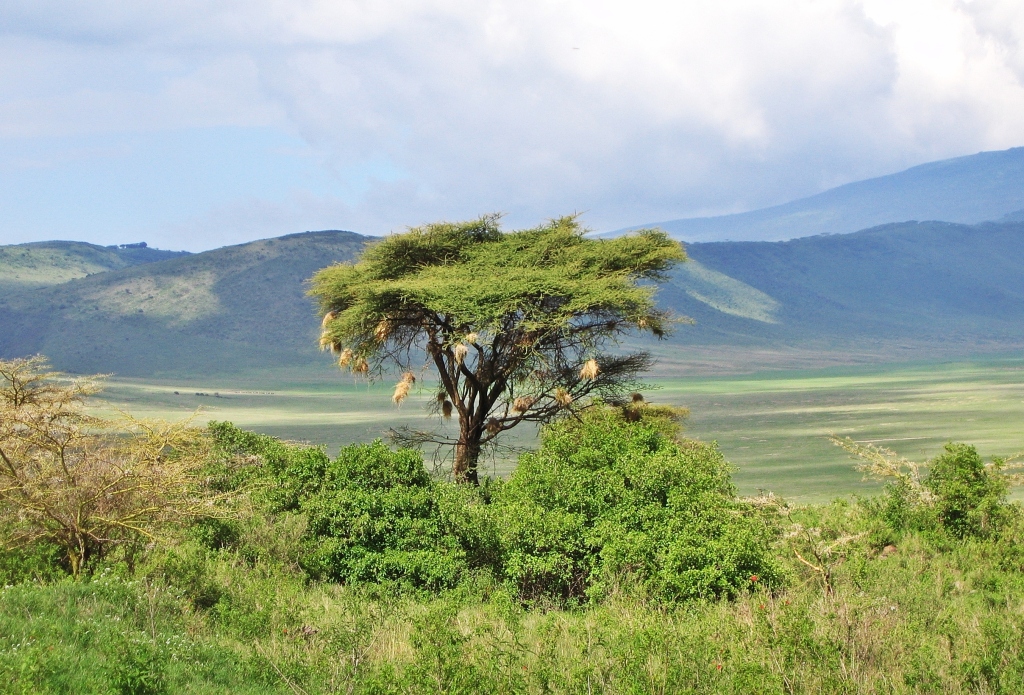
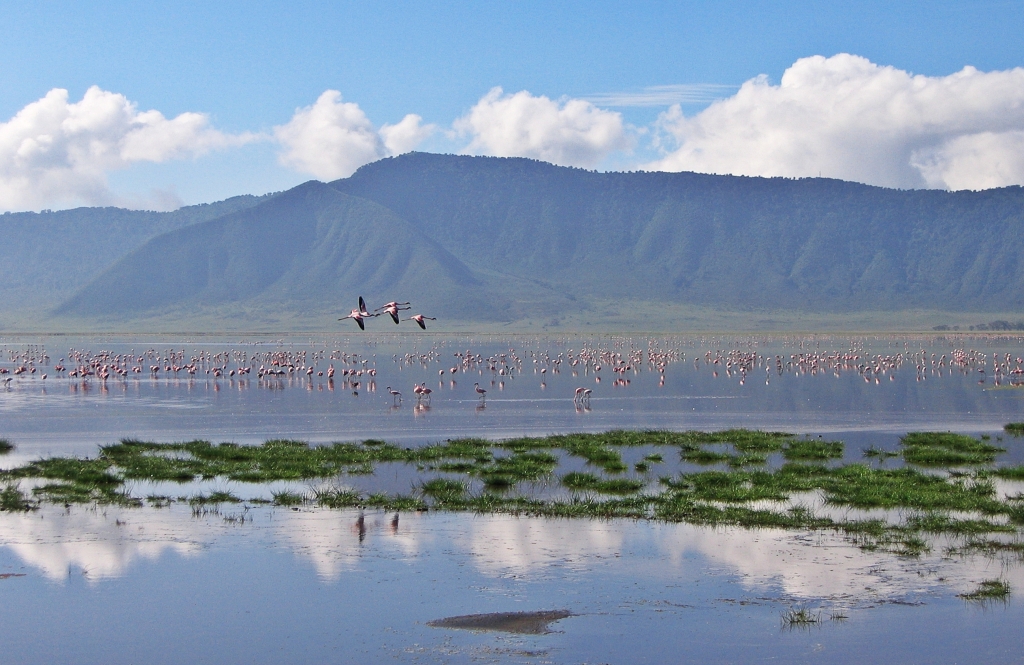
Again we found a park full of wildlife who carried on with their day as if we weren’t watching.
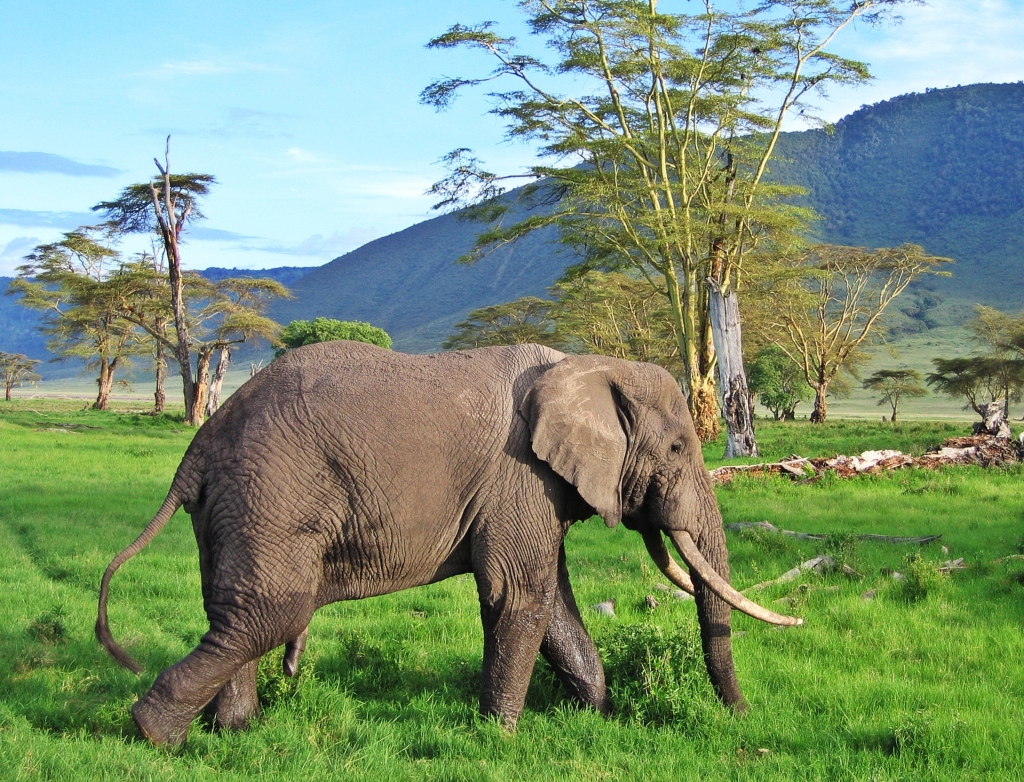
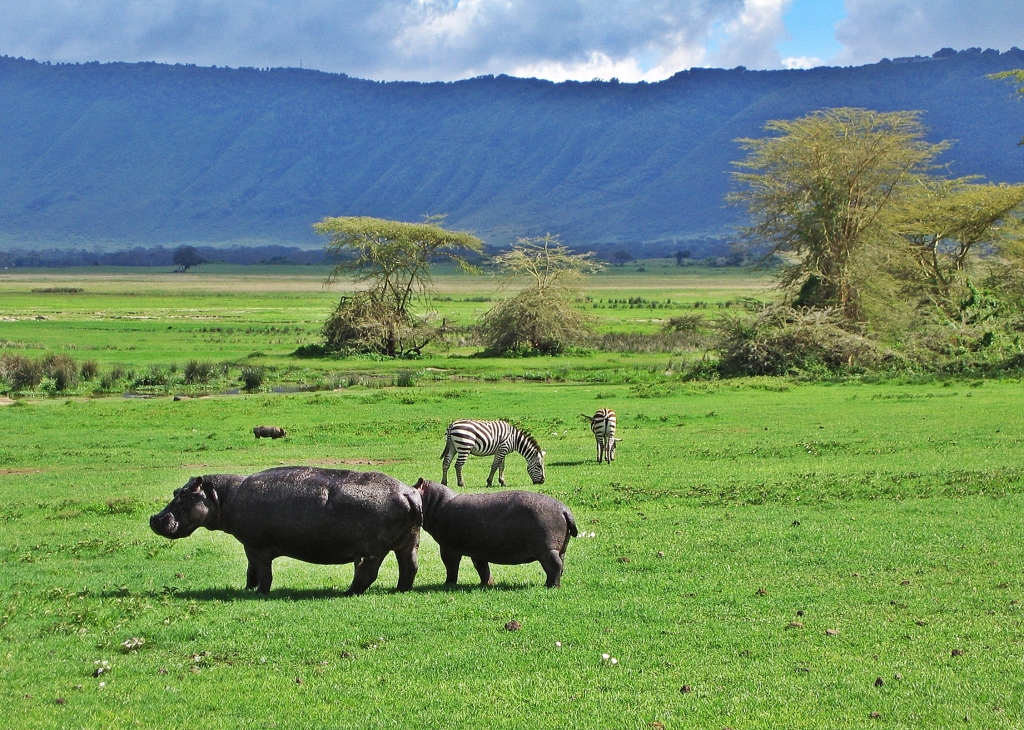
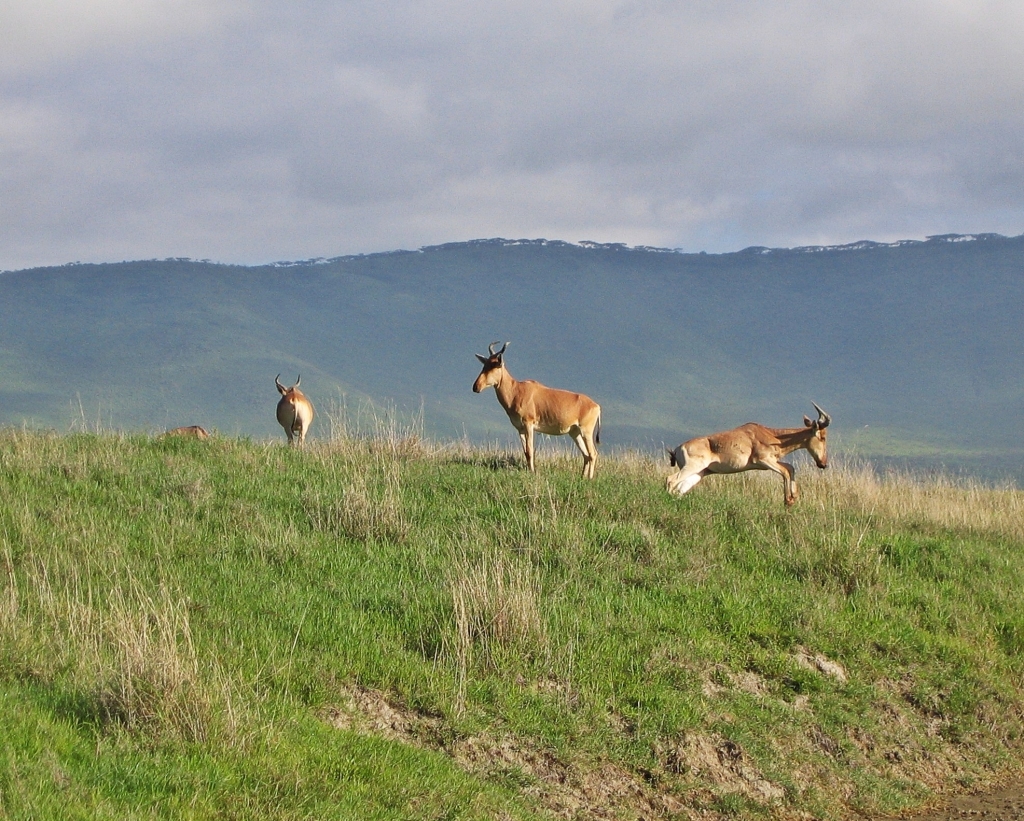

Zanzibar Island
After our safaris we traveled to Zanzibar Island. It is also called ‘Spice Island’ as it was an important trading post on the spice route. It has seen rulers from Oman and Yemn and later by the British and Portuguese. Indians came to the island as traders. All of these left their influence on the area so today it has a rich and unique culture.
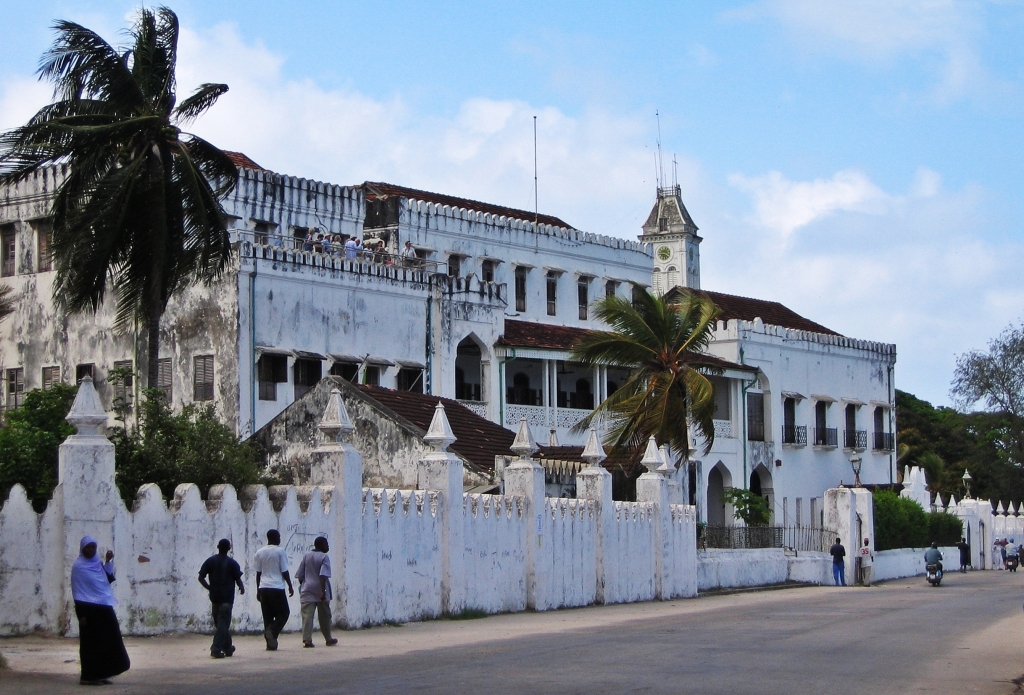
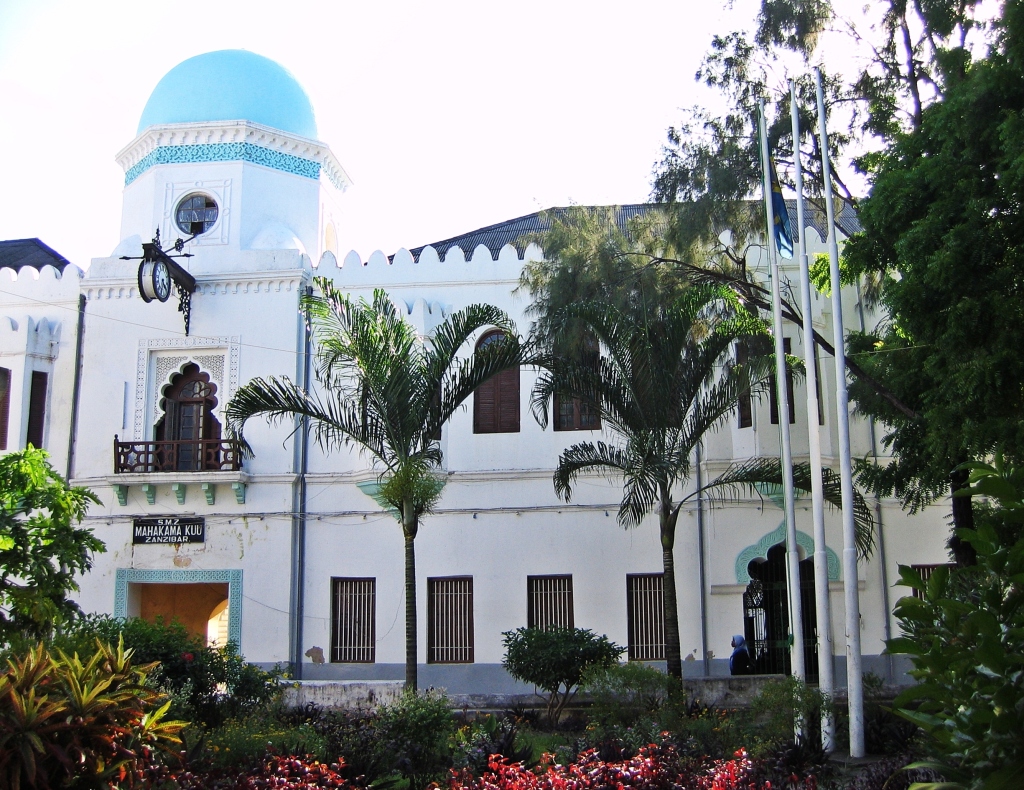

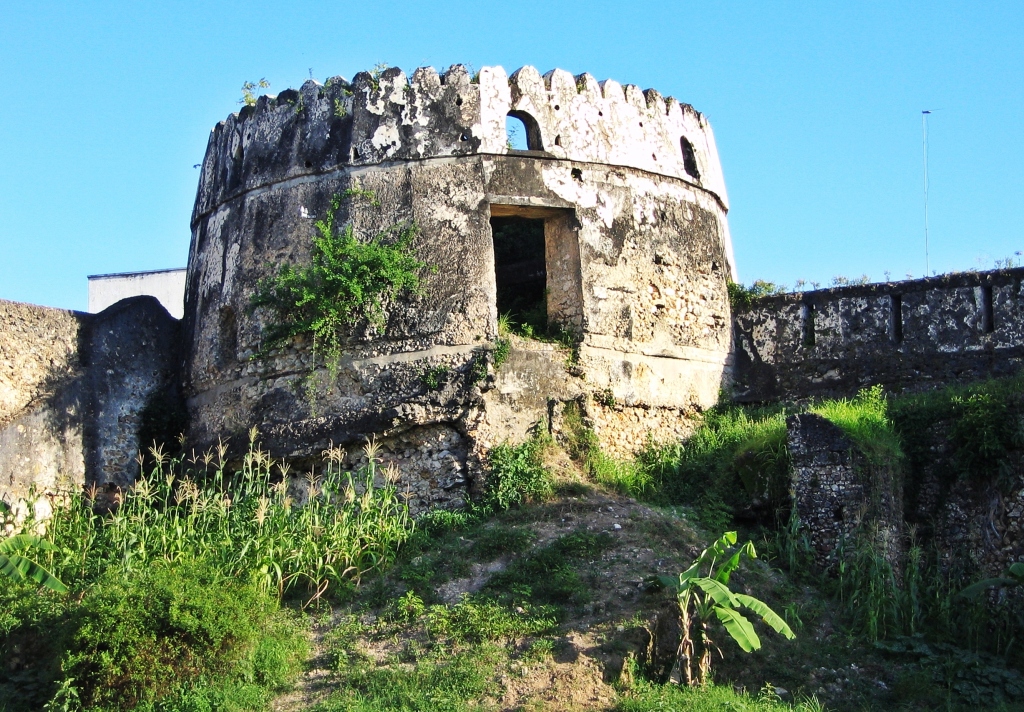
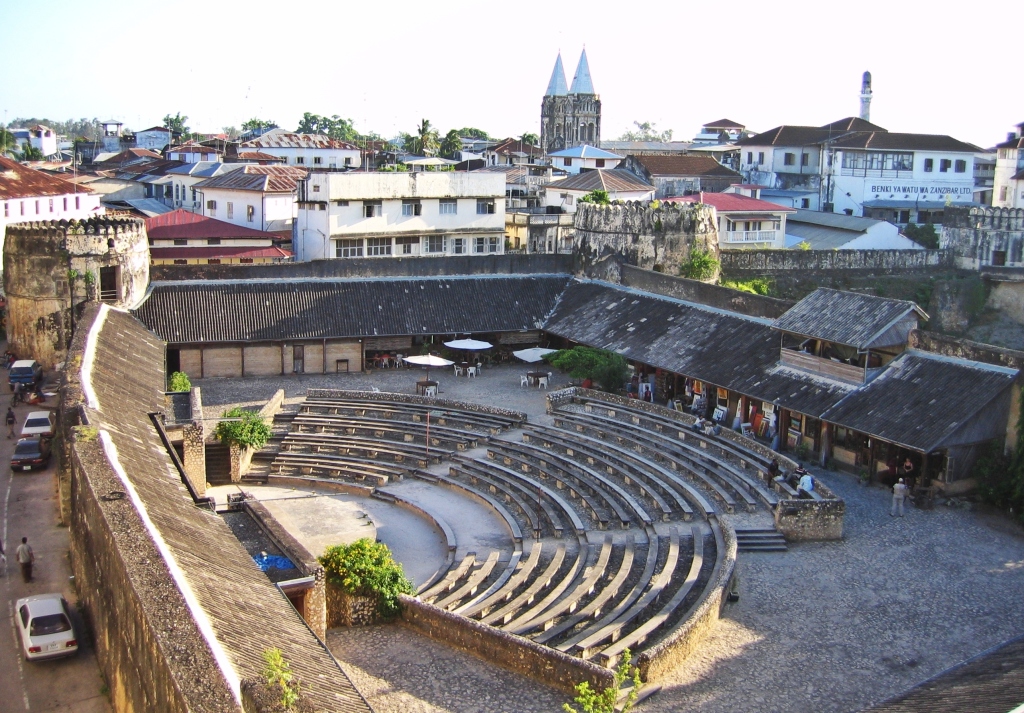
The main site of interest in Zanzibar Town is Stone Town. Narrow streets are bordered by old whitewashed buildings with interesting doors and windows. Its a great place to wander. The streets have many small shops selling fabrics, crafts and spices.
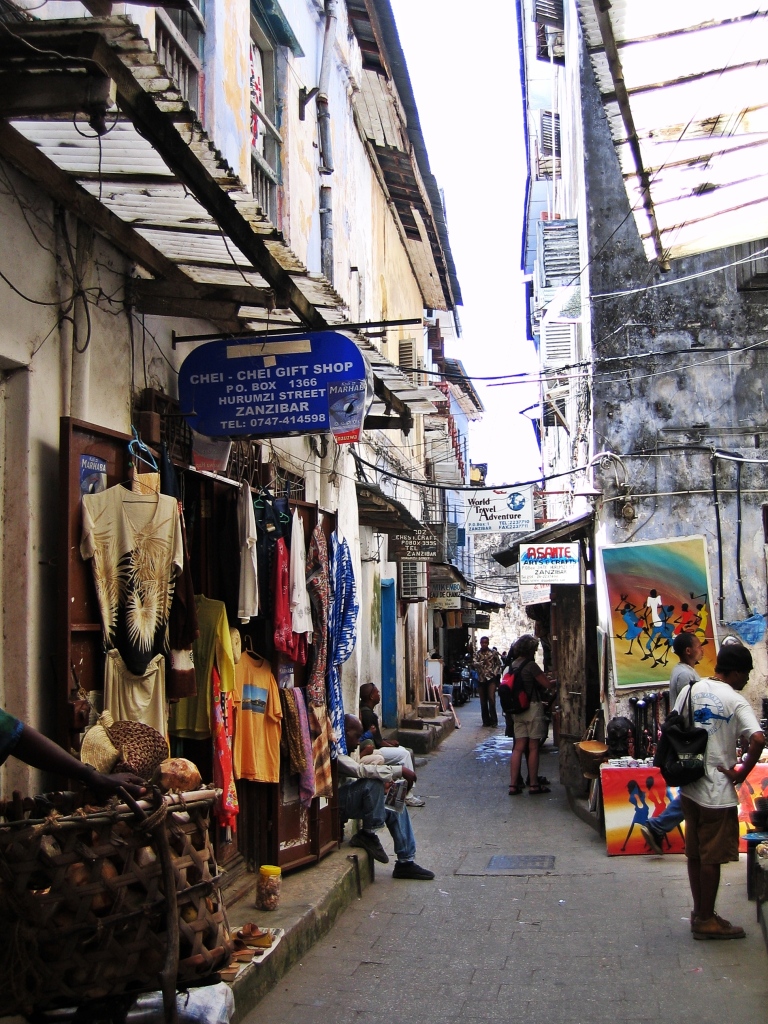
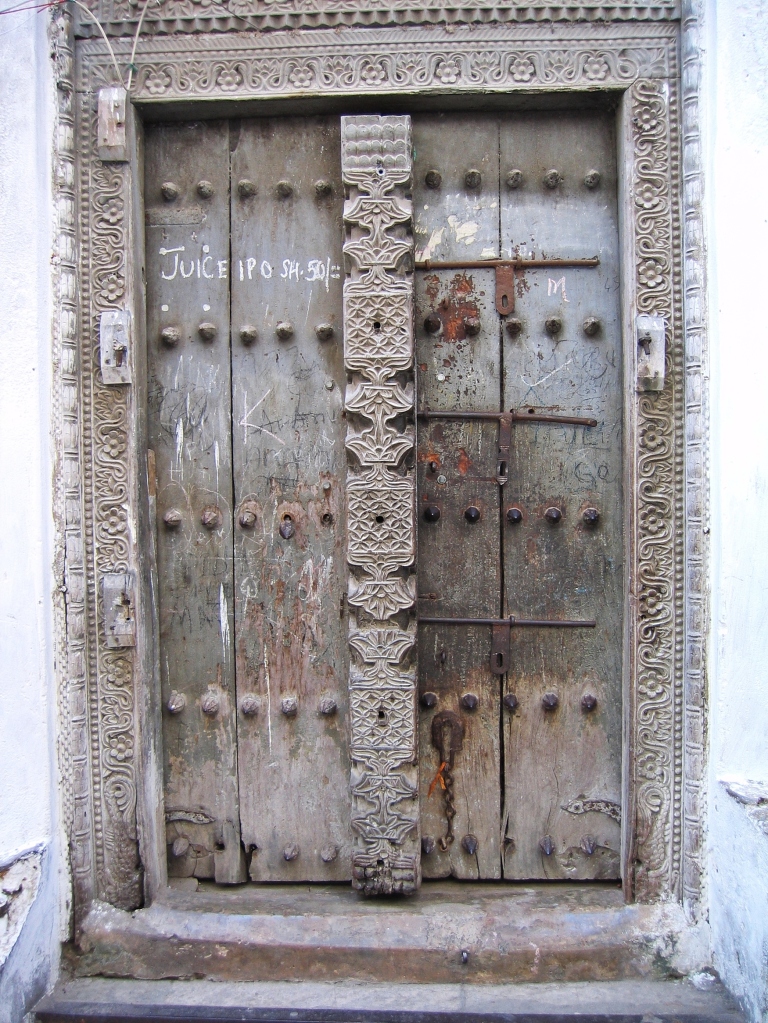
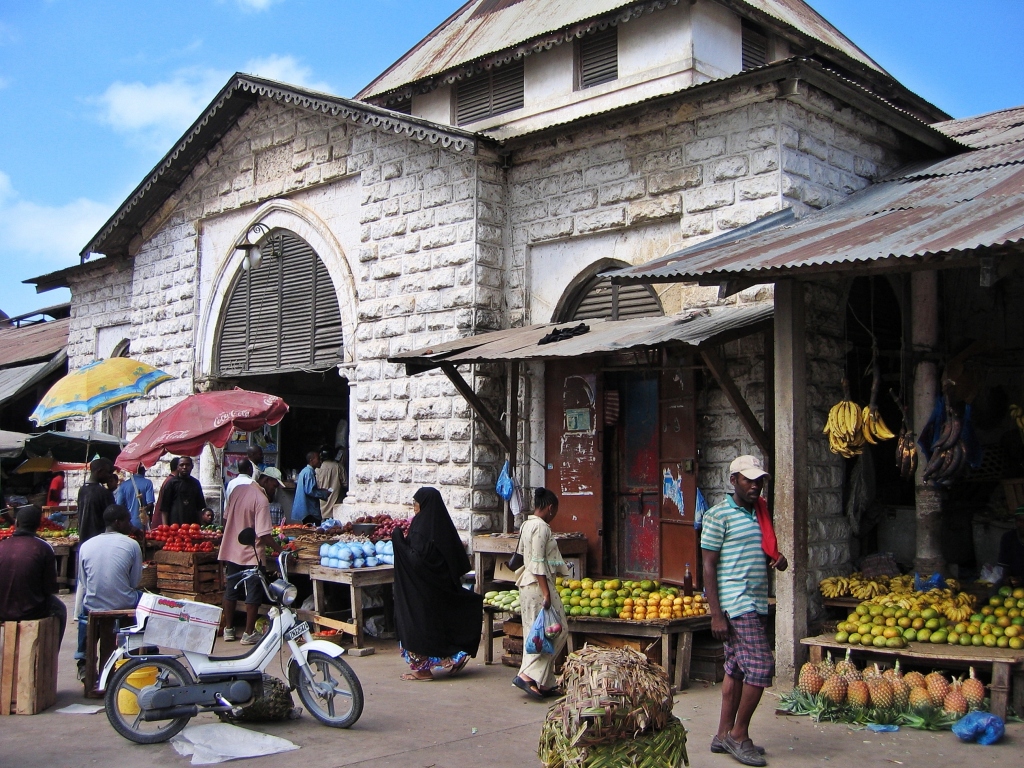
Unfortunately, its location means that it also has a disturbing history. In the centre of Stone Town is a reminder of how horrible humans can be to one another. Old holding cells used during the slave trade are now a part of the museum. We walked down a narrow, steep stairwell to reach the small, suffocating cells. The outer walls have small slits instead of windows that don’t allow much fresh air or light to enter. It was very hot and humid inside. The low ceilings and stuffy air made us feel claustrophobic. We could only stand it for a few minutes. It was difficult to think of the people who were kept in these cells for days. Many didn’t survive. Those who did were sold at the slave market.
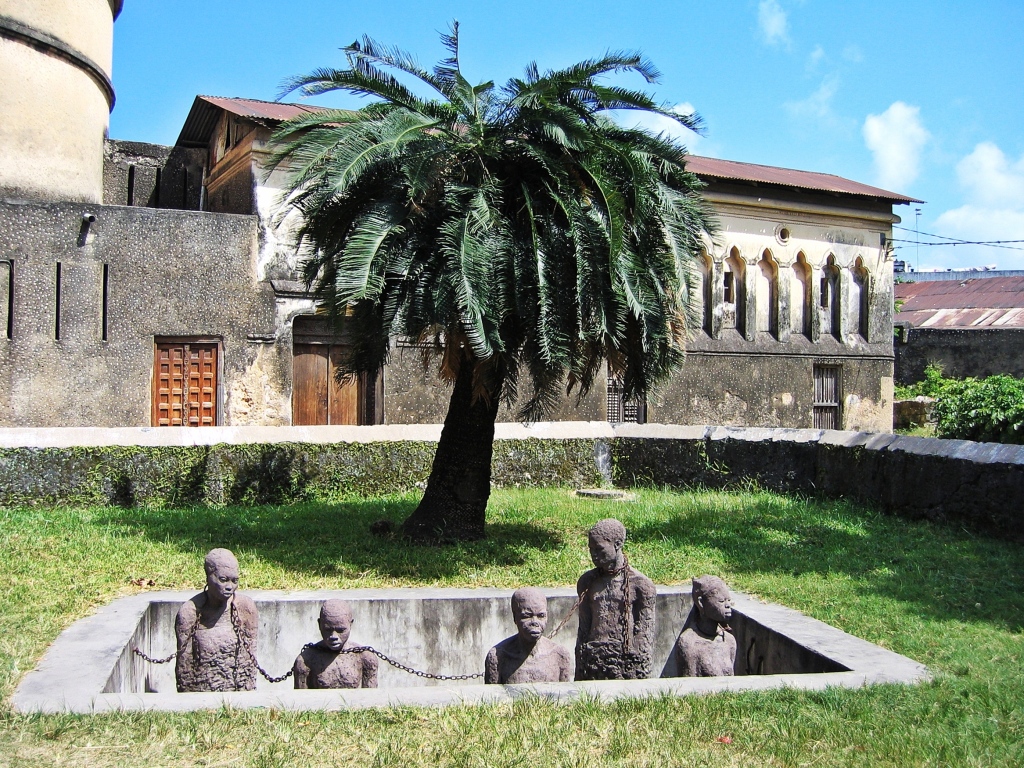
At one end of Stone Town is a colourful harbour with wooden dhow boats which are brightly painted. Old stone buildings line the harbour and add a unique texture.
The best part of Spice Island is the food. Their Indian heritage comes across in the flavourful curries and chutneys.

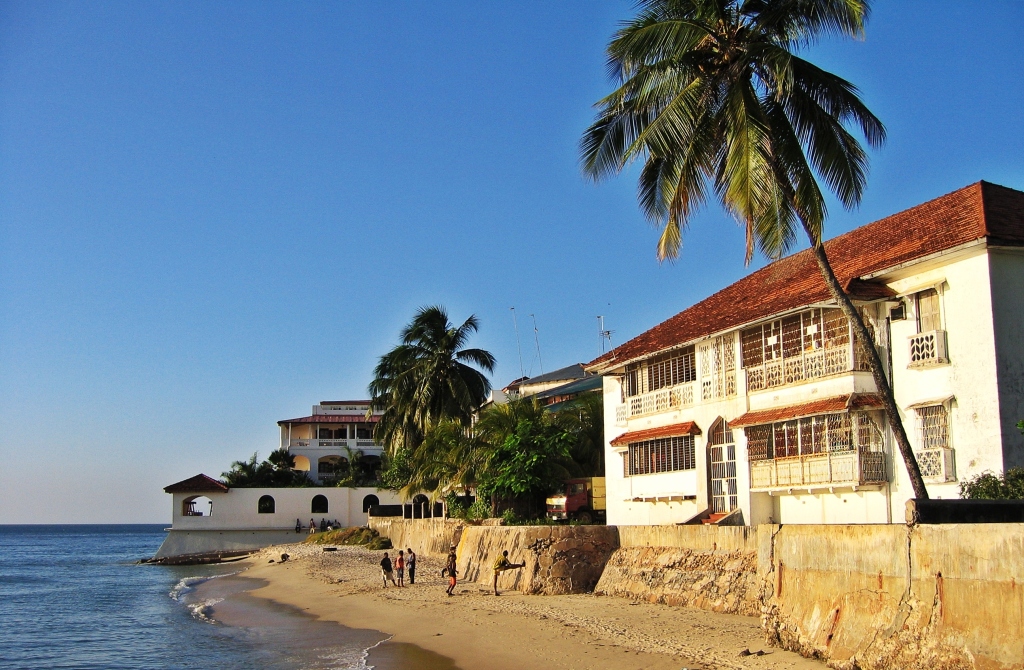
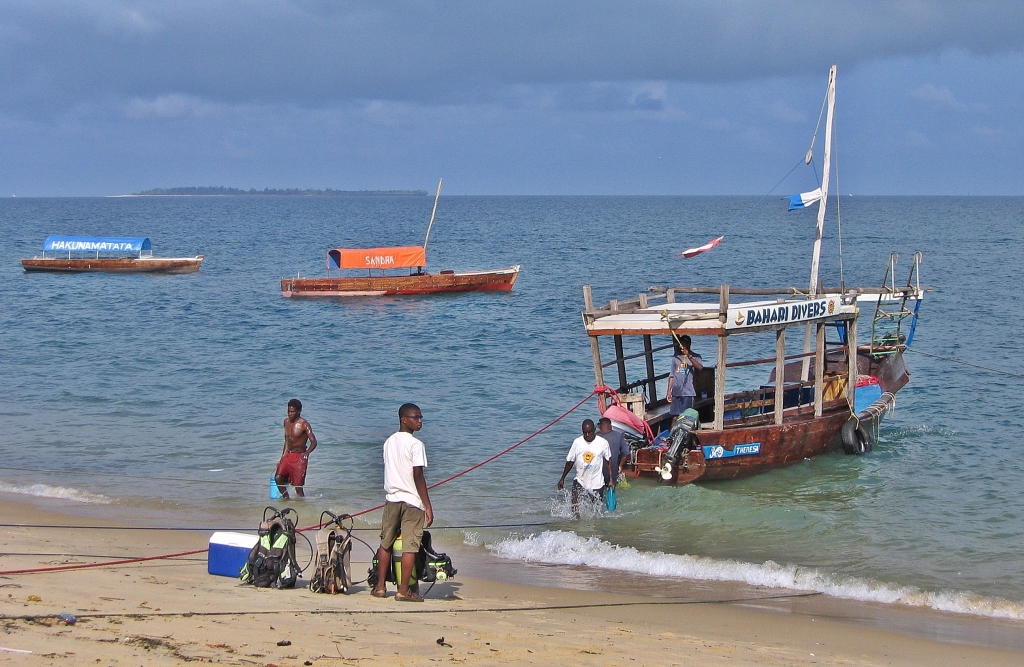
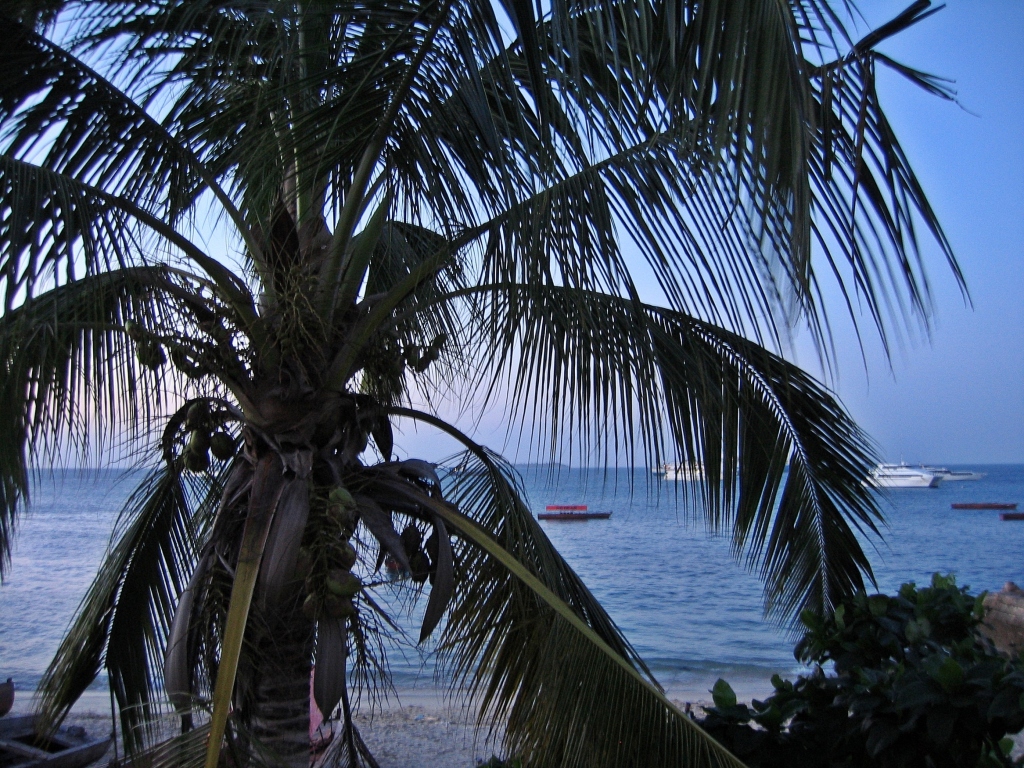
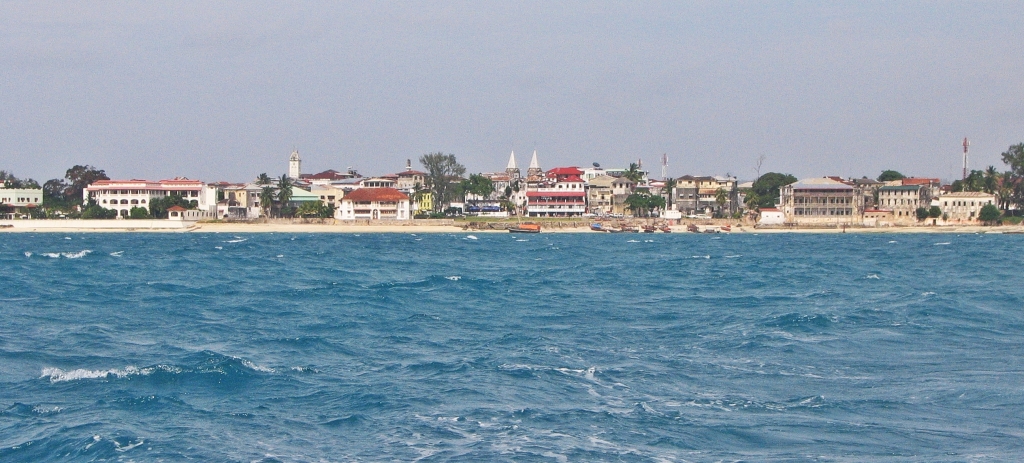
After summiting Kilimanjaro, we felt we deserved a reward and treated ourselves to a few nights at a beach resort on the east side of the island. The sand is perfectly fine, the water refreshingly warm and the cool ocean breeze kept us comfortable during the day.

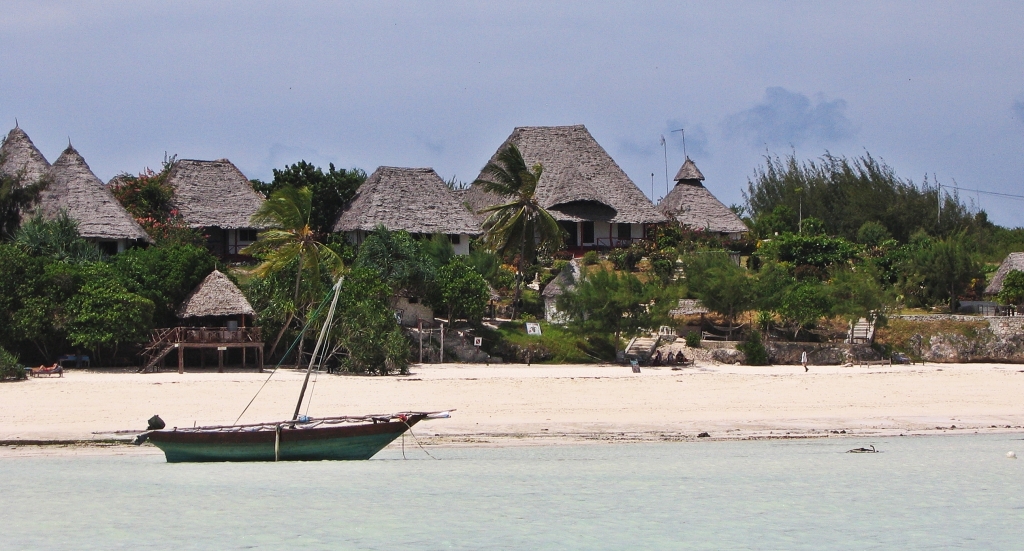
Coming Next: Climbing Mount Kenya
For extra pictures from Tanzania click here. For pictures from other blogs go to Gallery at monkeystale.ca
To read about more of our adventures go to Destinations.
If you like what you read, please comment or share (with credit) using the links below.
As ever, some wonderful memories shared along with great photos!!
LikeLiked by 2 people
Thanks Colin!
LikeLiked by 2 people
Most welcome! It was an enjoyable read 🙂
LikeLiked by 1 person
What a wonderful experience. Doubt we will get on safari ourselves, so thanks for taking us along. Stay well. Allan
LikeLiked by 2 people
Thanks Allan!
LikeLiked by 1 person
Loved reading about your experience! The photos were so so beautiful. An Masai Mara has been on my bucket list for really long but I’m going to add Tanzania to it too.
LikeLiked by 1 person
Yes, we also went to Masai Mara. We’ll post something about that trip too! Thanks for reading!
LikeLiked by 1 person
What a great post and stunning photography as usual.
LikeLiked by 1 person
Thanks Susan!!
LikeLike
Love it! Nat Geo eat your heart out. 😄
LikeLiked by 1 person
Thanks!!!!
LikeLike
Wow! You’re lucky to have seen so many animals there!
LikeLiked by 1 person
There are so many everywhere it’s difficult to not see this many! Thanks for reading! Maggie
LikeLike
Nice! And yet wildlife photographers wait hours to get even a few seconds of what they are looking for! Lol
LikeLiked by 1 person
What stunning photos. And what incredible adventures.
I stayed in my Dad’s camper bricked up on land I owned and would find scorpions dropping off magazines I’d pick up from the basket I kept them in. It is amazing to me my son and I never got bit from that nor did they crawl into our beds.
LikeLiked by 1 person
Yikes! I’d be pretty nervous with that many scorpions! The safari was incredible with so much wildlife living in the wild!
LikeLiked by 1 person
I love reading about your travel adventures, guys, you’ve been to so many amazing places! There’s nothing quite like seeing such amazing animals in their natural habitat. I usually get excited every time I see a Heron or a Hare in Sligo countryside, so I can only imagine at what level my adrenaline rush would be exploring Tanzania and running into zebras. Thanks for sharing and have a good day. I hope all is well 😊 Aiva
LikeLiked by 1 person
Thanks Aiva, a safari in Serengeti is everything you want it to be. It’s very unusual in the Canadian mountains to see wildlife even far from the road. But in Serengeti the animals are everywhere!
LikeLiked by 1 person
Isn’t it thrilling seeing those animals!? Love your Lion King photo and that gorgeous African sunset. I don’t know whether this was your first African wildlife adventure but your photos remind me of our first time seeing elephants, lions, giraffes… at Etosha National Park in Namibia. It was soooo exciting! We’ve since visited other parks in South Africa, Botswana and Zambia (all fantastic experiences) but haven’t made it to the Serengeti. We loved Zanzibar and like you, treated ourselves to a few beautiful days on the east coast. Africa really got under my skin and hopefully we’ll get to explore more of it. Your post has got me dreaming!
LikeLiked by 1 person
We are telling our story in reverse order. We climbed and went on 2 safaris in Kenya first. So it wasn’t our first, but still new enough to be amazing. We hope to go to Namibia in the next year (or so). Did you write blogs on Namibia? I’ll be sure to contact you when we start planning.
LikeLiked by 1 person
We were there about 10 years ago and I only did one short blog post about it. I should actually get my act together and at least post some photos as Namibia is in my top three favourite places I’ve ever visited. Happy to share our route and experiences.
LikeLiked by 1 person
A beautiful set of photos, I am captivated by those on animals. Having driven around the Kruger Park for several days, I am still frustrated to have seen so few animals, your experience is much better. For Zanzibar this is a destination I was thinking of, I didn’t imagine it to be so touristy yet. Thanks for taking the time to share it.
LikeLiked by 1 person
Oh I’m surprised at Kruger. There were so many animals in Serengeti and in Ngorogngoro. We didn’t expect so many tourists in Zanzibar either but its very popular. It’s still an interesting place to see.
LikeLike
Stunning photographs. I loved the post, as it felt as if I was there.
LikeLiked by 1 person
Thank you!
LikeLike
What a fantastic post this is! Those pictures of the safari are fabulous. I so hope I can be there in person some day.
LikeLiked by 1 person
Thank you! I hope you can too, it’s better than you can imagine.
LikeLiked by 1 person
FANTASTIC!!!!!!!! The first lion on the top kopjes picture is my favorite!! The sunset picture my second favorite!!!
LikeLiked by 1 person
Thanks Stephanie! The lion on the kopjes seemed to be posing for us!
LikeLiked by 1 person
Just incredible! Africa has been on my mind since I was a kid and saw Born Free…I have dreamt of visiting ever since. I definitely am a sucker for Out of Africa and have read so many books about Africa and the wildlife and people that have lived there to study the animals. Your pictures make me want to go even more. I can’t imagine being in a place that is so wild and yet has had to adapt to humans at the same time. One day!! Thanks for sharing 🙂
LikeLiked by 1 person
Our safaris in Tanzania and Kenya (coming soon) were everything we wanted them to be. Even though they were busy with tourists, we still saw an amazing amount of animals in their natural setting. We booked with local agencies rather than international tour groups and it wasn’t very expensive. Keep it in your plans!
LikeLiked by 1 person
Wow. guys these photos are just magnificent. not just amazing scenes but brilliant photography. well done guys!
LikeLiked by 1 person
Thanks Andy!
LikeLike
What a fabulous African journey so far. The safari pictures, especially, are dynamite. That lion lounging on the kopje seems to be practicing his “king of the jungle” look. Yet another reason it’s an apt nickname.
LikeLike
Great photographs (as ever with your blog!), but also for us, a great memory trip. Tanzania & Zanzibar (2 safari locations, Dar Es Salaam, Stone Town, then a few days at a beach resort) was actually our honeymoon trip in 2013. Your terrific post brought all our great memories flooding back, though we would say that your safari animal spotting was a good deal more varied than ours. We loved that trip – we are grateful for your post, it all looks so familiar even 7 years on…
LikeLiked by 1 person
Glad we brought you back to your honeymoon! A few people said they didn’t see as many animals on their safaris, but I don’t think we did anything special. It seemed that the animals were everywhere.
LikeLike
Great pics ! Thanks for sharing!
LikeLiked by 1 person
Thank you!!
LikeLike
Zanzibar’s Old Town is one of the cities in Africa (with Massawa and Asmara in Eritrea) I’d like to visit one day… My favourite photo was the buffalo hanging in the mud pool: I doubt an animal can look any more comfy than that guy!
LikeLiked by 1 person
We really enjoyed Zanzibar, even though there were a lot of tourists. It has such a unique culture. Love the buffalo pick too. He was just chillin’
LikeLiked by 2 people
Serengeti does provide some of the best wildlife on the African continent. Along with Serengeti, Kruger and Masai Mara are the best wildlife games.
LikeLiked by 2 people
It’s pretty incredible how many animals live in the parks and how easy it is to see them. Thanks for reading Arv!
LikeLiked by 1 person
Cool. 😊
LikeLiked by 1 person
Great post! Amazing photographs! Each one is a breathtaking!
LikeLiked by 1 person
Thank you so much!
LikeLike
Oh, that sunset photo! They were all really beautiful, thank you for that tour.
LikeLiked by 1 person
Thank you!
LikeLike
Ahhh this is my ultimate bucket list dream! It’s our plan for our honeymoon – Serengeti followed by Zanzibar! Looks absolutely amazing and I loved reading about your experiences. 🙂
LikeLiked by 1 person
What a great honeymoon! We loved both places. Look at Ngorongoro to add on to your safari as well.
LikeLike
Enjoyed your post. Thinking about a return trip to Africa (probably our fav trip) and visiting these areas. Wonderful pictures!
LikeLiked by 1 person
Thank you, this trip was a while ago, so we’d love a return trip too 😊 Maggie
LikeLiked by 1 person